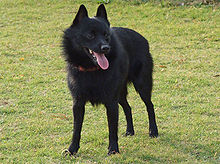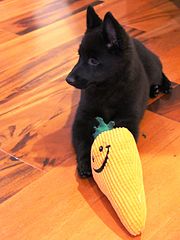Schipperke
This article needs additional citations for verification. (June 2007) |
| Schipperke | |||||||||||||||||||
|---|---|---|---|---|---|---|---|---|---|---|---|---|---|---|---|---|---|---|---|
 | |||||||||||||||||||
| Common nicknames | Spitzke (until 1888) Spits (until 1888) Spitske (until 1888) | ||||||||||||||||||
| Origin | Belgium | ||||||||||||||||||
| |||||||||||||||||||
| |||||||||||||||||||
| Dog (domestic dog) | |||||||||||||||||||
A Schipperke (/ˈskɪpərkiː/; Dutch: [ˈsxɪpərkə]) is a small Belgian breed of dog that originated in the early 16th century. There has been a long informal debate over whether this type of dog is a spitz or miniature sheepdog. In their home country of Belgium they are considered a small shepherd.[1]
Description

Their small, pointed ears are erect atop the head. Schipperkes are double coated with a soft, fluffy undercoat that is covered by a harsher-feeling and longer outer coat. One of the breed characteristics is a long ruff that surrounds the neck and then a strip trails down towards the rear of the dog. They also have longer fur on their hind legs called culottes. The breed is black, or blonde (some blondes have a silkier coat), and the coat is shiny.
Dogs of this breed usually weigh 3–9 kg (6.6–19.8 lb). Puppies are born with tails in different lengths. In Canada and the United States, the tail is usually docked the day after birth. In countries that have bans on docking, Schipperkes display their natural tails, which vary in type.
Known for a stubborn, mischievous, and headstrong temperament, it also chases small animals. The Schipperke is sometimes referred to as the "little black fox", the "Tasmanian black devil", or the "little black devil". They are naturally curious and high-energy dogs and require ample exercise and supervision. Schipperkes are very smart and independent; and sometimes debate listening to owners, instead choosing to do whatever benefits them the most, and are not necessarily the proper dog for a first-time dog owner. Schipperkes require training and a secure, fenced-in space to run. They are formidable barkers and can be aggressive with other dogs. Otherwise they are overall good dogs, and their personality is a matter of how they are raised, and who they are around. They often have a high prey drive, focusing on rodents and small animals, and can excel at obedience and agility competitions.[2]
Health

The Schipperke has no particular health problems. The UK Kennel Club survey puts the median lifespan of the breed at 13 years old, with about 20% living to 15 years or more. Of the 36 deceased dogs in the survey, the oldest dog was 17+1⁄2 years old.[3] Nonetheless, inactivity, lack of exercise and over-feeding are very harmful, and can lead to joint and skeletal problems and tooth, heart, lung or digestive conditions. Schipperke's primary orthopedic problem tends to be luxating patella and Legg-Perthes syndrome. Some Schipperkes have demonstrated tendencies to epilepsy, although there are no tests: these seem to be related to genetic transmission.[4]
The one caveat to the Schipperke's good health is MPS IIIB, a genetic mutation that occurs in at most 15% of the total breed population. It only occurs in Schipperkes. The University of Pennsylvania School of Veterinary Medicine has developed a test for the disease and began accepting samples in April 2003.[5] Clinical signs appear between two and four years of age, and there are no known cures or treatments. The disease affects balance, negotiation of obstacles (such as stairs), and is similar to such lysosomal storage diseases in humans as Tay Sachs disease and Gaucher disease.[6] The Schipperke is also prone to some other physical problems as reported by the Orthopedic Foundation for Animals.[7]
Grooming

The Schipperke does not need expensive or excessive grooming. This breed is a moderate shedder, however. A brush that can reach the undercoat is the best. Regular weekly brushing is usually enough to keep the coat in good condition. There is no need for cutting or trimming and the ruff (hair around the neck) fluffs up naturally.
Schipperkes can "blow" their coats up to several times a year, and usually females more frequently than males. When this happens, they lose their undercoat. Owners typically find warm baths helpful during this time to remove the undercoat, rather than getting fur all over the home. Blowing their undercoat can last several days or weeks, and can take up to 2–3 months for Schipperkes to grow back.
History

Schipperkes were first recognized as a formal breed in the 1880s, their standard being written in 1889. Much of what is known of their origins and early history comes from Chasse et Pêche (French for "Hunting and Fishing") magazine, articles of which were translated into English and published by the English magazine The Stockkeeper.
The breed name of "Schipperke", in English-speaking nations, was thought to mean "little boatman". However while they were occasionally seen on barges it was not their original or primary function, and in the areas of Leuven and Brussels "schipper" was the word for shepherd, making the name translate as "little shepherd".[1]
Before the name "Schipperke" was officially taken, the breed was also known colloquially as "Spits" or "Spitzke", a name commonly used to describe a small dog with pointed ears. They were also occasionally called "Moorke", meaning "little black animal". Schipperkes are widely referred to in the United States, albeit erroneously, as "Belgian barge dogs" or "Belgian ship dogs." Apparently, however, their history dates to a seventeenth century black shepherd dog commonly called the Leuvenaar, a 40-pound dog often found in the Louvain region of Belgium and employed to guard flocks and transport. These dogs are apparently the foundation breed for both the modern, and smaller, Schipperke and the modern, and larger, Black Belgian Shepherd Dog, also known as the Groenendael.[8]
In World War II, the Belgian Resistance used the dogs to run messages between various resistance hideouts and cells, to which occupying Nazi Forces were none the wiser.
A Schipperke is intermittently featured in the tiger-centric movie Two Brothers (2004), and also appears in Daphne Du Maurier's short story A Borderline Case.
See also
- Belgian Shepherd Groenendael, also known as the Black Belgian Shepherd.
- Belgian Shepherd Laekenois
- Belgian Shepherd Malinois
- Belgian Shepherd Tervuren
References
- ^ a b The Schipperke … what’s in a name? By Dr. Robert Pollet
- ^ Schipperke Club, Club Flyer AKC, Sept. 2008.
- ^ "Individual Breed Results for Purebred Dog Health Survey".
- ^ Skipperke Club, p. 2
- ^ University of Pennsylvania, School of Veterinary Medicine, Mucopolysaccharidosis IIB (MPS IIIB), 2008
- ^ University of Pennsylvania, School of Veterinary Medicine, "New DNA-based Test for Inherited Diseases in Schipperkes." The Bellwether 56:Sept. 2003, pp 7, 9.
- ^ Schipperke health survey. Orthopedic Foundation For Animals. offa.org
- ^ American Kennel Club, History of the Skipperke, AKC, 2013.
External links
- Schipperke FCI Breed Standard - http://www.fci.be/en/nomenclature/SCHIPPERKE-83.html
- Template:Dmoz
